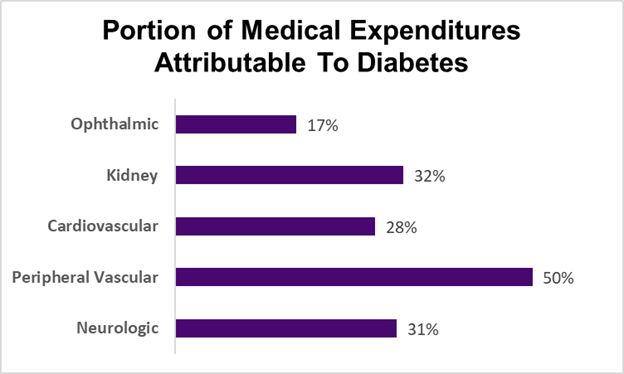Source: Parker, et al Diabetes Care November 1, 2023 LINK
November is National Diabetes Month, a time to remind ourselves that diabetes remains a large and growing challenge in the United States and globally. Diabetes affects between 25 and 37 million in the US; people with diabetes are at risk of premature heart, vascular, kidney, and eye disease. Drugs to treat diabetes continue to improve, but can be exceptionally expensive. Most plans at this point offer insulin for a copayment of $35 or less a month, a large improvement over the past few years. The GLP-1 medications, initially developed for diabetes but now also used to treat obesity, have become so popular that they are in short supply.
Researchers from the American Diabetes Association created a computer model to estimate the medical and non-medical costs of diabetes in the United States in 2022. They found that diabetes was responsible for $413 billion in economic costs; about three quarters of this was incremental medical costs, and a quarter were indirect costs such as lost productivity. About 8% of Americans have diagnosed diabetes, and they represent about a quarter of all medical expenses. Almost a quarter of those with diabetes don’t know they have it; they are at high risk of hospitalization and poor outcomes. Sixty one percent of the cost of caring for people with diabetes is attributable to diabetes directly, and 17% of the cost of caring for people with diabetes was pharmacy spending. High unit costs for pharmaceuticals and for hospitalizations make diabetes exceptionally expensive in the US.
There is a lot of room to improve the care of diabetes. Here are a few diabetes quality metrics from the National Committee on Quality Assurance (NCQA).
Implications for employers:
- Diabetes continues to be a major cause of medical expenses and medical complications.
- Good care of diabetes can help prevent complications, including heart attacks, strokes, kidney failure and amputations.
- Diabetes is also a major cause of time away from work, and parents of young children with diabetes face special caregiving challenges.
- Employers can ask for reporting or performance guarantees on the quality of diabetes care for their members - including standard quality metrics, medication adherence, and preventable complications of diabetes.
- Employers can also offer diabetes medications or testing supplies with no or low cost share to encourage adherence. They can also cover continuous glucose monitors and insulin pumps under both the medical and pharmacy benefit
- Employers can consider partnering with chronic condition management vendors for diabetes and conduct evaluations to assess program effectiveness.
- The GLP-1 drugs that are used for obesity have been shown to decrease both major cardiovascular events and kidney decline in diabetics, so we should expect an increase in use of these drugs which could improve diabetes control.
Monday: Full body scans in those without symptoms will raise medical costs
Thanks for reading. You can find previous posts in the Employer Coverage archive
Please “like” and suggest this newsletter to friends and colleagues. Thanks!




